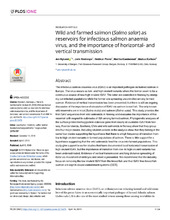| dc.contributor.author | Nylund, Are | |
| dc.contributor.author | Brattespe, Jarle | |
| dc.contributor.author | Plarre, Heidrun | |
| dc.contributor.author | Kambestad, Martha Amalie | |
| dc.contributor.author | Karlsen, Marius | |
| dc.date.accessioned | 2020-03-31T10:51:23Z | |
| dc.date.available | 2020-03-31T10:51:23Z | |
| dc.date.issued | 2019-04-16 | |
| dc.Published | Nylund A, Brattespe J, Plarre H, Kambestad M, Karlsen MK. Wild and farmed salmon (Salmo salar) as reservoirs for infectious salmon anaemia virus, and the importance of horizontal- and vertical transmission. PLOS ONE. 2019;14(4):e0215478 | eng |
| dc.identifier.issn | 1932-6203 | en_US |
| dc.identifier.uri | http://hdl.handle.net/1956/21636 | |
| dc.description.abstract | The infectious salmon anaemia virus (ISAV) is an important pathogen on farmed salmon in Europe. The virus occurs as low- and high virulent variants where the former seem to be a continuous source of new high virulent ISAV. The latter are controlled in Norway by stamping out infected populations while the former are spreading uncontrolled among farmed salmon. Evidence of vertical transmission has been presented, but there is still an ongoing discussion of the importance of circulation of ISAV via salmon brood fish. The only known wild reservoirs are in trout (Salmo trutta) and salmon (Salmo salar). This study provides the first ISAV sequences from wild salmonids in Norway and evaluates the importance of this reservoir with respect to outbreaks of ISA among farmed salmon. Phylogenetic analyses of the surface protein hemagglutinin-esterase gene from nearly all available ISAV from Norway, Faeroe Islands, Scotland, Chile and wild salmonids in Norway show that they group into four major clades. Including virulent variants in the analysis show that they belong in the same four clades supporting the hypothesis that there is a high frequency of transition from low to high virulent variants in farmed populations of salmon. There is little support for a hypothesis suggesting that the wild salmonids feed the virus into farmed populations. This study give support to earlier studies that have documented local horizontal transmission of high virulent ISAV, but the importance of transition from low- to high virulent variants has been underestimated. Evidence of vertical transmission and long distance spreading of ISAV via movement of embryos and smolt is presented. We recommend that the industry focus on removing the low virulent ISAV from the brood fish and that ISAV-free brood fish salmon are kept in closed containment systems (CCS). | en_US |
| dc.language.iso | eng | eng |
| dc.publisher | Public Library of Science (PLoS) | en_US |
| dc.rights | Attribution CC BY | eng |
| dc.rights.uri | http://creativecommons.org/licenses/by/4.0/ | eng |
| dc.title | Wild and farmed salmon (Salmo salar) as reservoirs for infectious salmon anaemia virus, and the importance of horizontal- and vertical transmission | en_US |
| dc.type | Peer reviewed | |
| dc.type | Journal article | |
| dc.date.updated | 2020-02-04T11:05:04Z | |
| dc.description.version | publishedVersion | en_US |
| dc.rights.holder | Copyright 2019 The Author(s) | en_US |
| dc.identifier.doi | https://doi.org/10.1371/journal.pone.0215478 | |
| dc.identifier.cristin | 1710235 | |
| dc.source.journal | PLOS ONE | |

